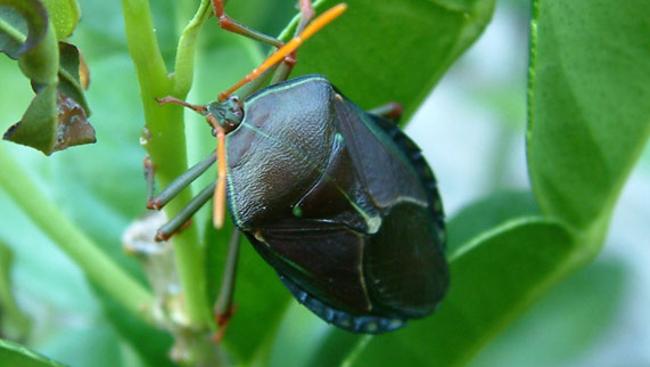Garden tips: stink bugs; millipedes; jacarandas; citrus rootstock
A new spray is designed to rid your orange and lemon trees of pesky stink bugs.

How can I get rid of the disgusting stink bugs infesting my lemon and lime trees?
ELIZABETH COLEMAN, BY EMAIL
For the first time there is a product registered to spray bronze orange bugs on edible citrus. Yates Nature’s Way Citrus and Ornamental Spray is certified organic and works via contact, so thorough spraying is needed and repeat sprays may be necessary. Otherwise, tap branches with a stick to cause the bugs to drop into a bucket of hot soapy water held below, or use an old vacuum cleaner with disposable bag. Always wear eye protection as they squirt a caustic fluid.
My garden has numerous black worms, with many legs like a centipede, that curl into a flat circle when touched. What are they? Do they attack plant roots?
BARBARA BUSK, ALTONA, VICTORIA
Portuguese millipedes consume mostly decaying plant matter and occasionally soft fruits but not living roots. Although harmless, they can invade in hordes, especially in moist conditions. They’re attracted by light, which can take them indoors where they dry out and die. A chemical-free light trap, endorsed by Landcare, is available from millipedecatchers.com. Nematodes (from bugcentral.com.au) are a safe, biological control but need a year or two for full effectiveness.
I’d love to grow a big jacaranda tree. I have the room. The soil is clay, hard and rocky and rainfall is low. Temperatures range from minus 3C to 48C. Might it work?
CHRISSY ROBERTS, TOODYAY, Western Australia
Native to Brazil where they are dry season deciduous, jacarandas grow best in the warmer parts of NSW and Queensland, on rich but well-drained soil. They’ll grow in other areas in a sheltered spot, although more slowly, and they may not flower as profusely. Given frost protection when young, they should then withstand minus 3C. Spend some time improving your soil with compost. Keep well mulched in summer.
Should I continually remove the vigorous, thorny growth, which I presume is the rootstock, from my orange and lime trees? Does it do any damage if I leave it?
BARB O’DONOVAN, GERALDTON, Western Australia
If you don’t promptly remove all shoots from below the graft, the more vigorous rootstock will overtake your desirable, grafted varieties and potentially kill them. Once rootstocks start to sucker they usually keep sending up shoots. Keep rubbing them off when young and soft.
Send questions to: helenyoungtwig@gmail.com or Helen Young, PO Box 3098, Willoughby North, NSW 2068. Website: helenyoung.com.au. The best question for December wins a signed copy of The Australian Native Garden by Angus Stewart and AB Bishop, worth $50.
FLORA
At Wageningen University in The Netherlands, researchers have built an instrument that chews food much like people do, to measure the many aromas released from fresh fruit and vegetables that so greatly influence taste. As the “chewing” progresses, the PTR-MS (Proton Transfer Reaction — Mass Spectrometry) equipment, which resembles a jam jar with a set of false teeth, captures and measures the aromas, second by second. The information will be used to improve handling of fresh produce between harvest and consumption. It readily proves that tomatoes stored in the fridge, even for a few hours, suffer irreversible flavour loss. The aromameter also has promise for plant breeders looking to improve flavours in crops such as strawberries.




To join the conversation, please log in. Don't have an account? Register
Join the conversation, you are commenting as Logout